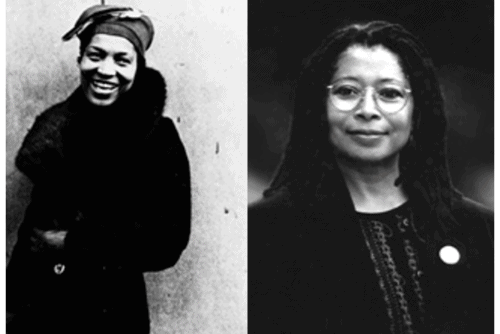Kathleen: There’s a pathos in Chicas’ story of Carmelita and her clones.
Carmelita: They’re looking for their mother.
Ela: Not their mother, their bio original.
Carmelita: Both Clana and Cluna live separately in facilities for clones; they are incarcerated. They escape and they set out to find their bio original. They want to be a family. That’s what they’re looking for.
Ela: In Post Plastica, Ursa is cloned from a bear, but her human bio original is Albert Einstein. She’s a brilliant scientist.
Kathleen: That’s quite a genealogy. You are querying reproduction, but keeping an emotional and absurdist focus. Are you thinking about different kinds of reproducing?
Carmelita: It is a fantasy where we imagine the future and different methods of reproduction, whether it’s cloning or engineering a new transpecies. What do those biological and technological changes mean? What are the implications, the bioethics involved? What do those changes mean in terms of ethics and morality?
Ela: When I started reading about genetically modified food, I thought it was really interesting. But I was thinking of its potential to benefit us. The medical potential to grow human organs was incredible. But instead we’re finding out that Monsanto is copywriting or branding their seeds, which is ridiculous. So these amazing scientific discoveries are being co-opted by greedy corporations. That is why in Post Plastica we have leaders, but instead of being presidents, they are CEOs.
Carmelita: It’s the CEO who rules the planet, and controls food production.
Ela: The CEO controls honey production; she has created her own honey, a new kind of bioengineered honey that may be tasteless. The real honey from the bees is natural, but illegal.
Kathleen: So you were kind of thinking about Monsanto.
Ela: Not Monsanto specifically, but rather addressing serious global problems.
We’re interested in all these ideas but in Post Plastica, they are a part of Ho’s thinking and her life as an artist, her relationship with her protégé. When Plastica steals her ideas for a show, she becomes desperate and she Botoxes herself.
Kathleen: Can you talk about the CEO and the fact that she’s both a holographic animation and flesh-and-blood? Her embodiment is different than Ho’s because Ho is what you call an ancient female.
Carmelita: Ho went into a coma in the year 2012. We were thinking—what if Ho was preserved like a mummy, like King Tut, and what if King Tut then came to life. Ho, wanting to be young, injected herself with Botox; she then is awakened in 3000 and is revered as the ancient. Her brain acts as a repository of the history of the twentieth and twenty-first century.
Ela: Ursa has fallen for Ho; she has been studying Ho’s memories and dreams. But she has a romanticized view of the ancient Ho and Ho’s life in the past. She also has a complete misreading of history, which is our way of rewriting history.
Kathleen: I love the screen above Ho that shows her thoughts. When Ursa plays with the toy dog, Ho’s mind conjures up an image of her dog that we see on the screen.
Carmelita: Right. Ursa is trying to wake Ho up and recreates the last moments when Ho went into her coma to see if they act as triggers. Ursa gives her Coke, Mentos, and plays with a toy dog barking, simulating Ho’s dog Larry. And Ho wakes up.
Kathleen: Like Sleeping Beauty, but with a dog! You’ve got many and diverse cultural references throughout Post Plastica: Edison and the electrocution of the elephant; Obama; Al Green; Occupy. How did you choose from all the things you could have selected?
Ela: We had to be selective in terms of the story. For example, we were interested in elephants. But the elephant appears in different forms throughout Post Plastica.
Carmelita: In the seduction scene with Ursa, Ho talks about Ganesh, the Indian god that is a hybrid, with an elephant head and human body. We also wanted to use the iconic film available on YouTube where Topsy the elephant is electrocuted by Edison to prove the power of electricity.
Ela: It was really horrific to have filmed it as a spectacle, to show how powerful electricity could be, that the electric shock could kill such a large elephant.
The bees were also really important within the story, with underground, and the story of the drones, with technology.
Carmelita: There were other iconic or popular images on the web we used, like Tahir Square and people with cell phones at demonstration.
Ela: At the time, I was watching all the protests of the Arab Spring in real time, watching it live on Al Jazeera. Everyone was feeding information through their cell phones, so the revolution was being carried on via cellphone technology.
Carmelita: Right now, today, Syria has been out of—they have cut the Internet for 20 hours. It’s really horrible because that means that you do not know what’s going on. That’s really warfare, but warfare fought in very different ways. Through technology.
Kathleen: The drones in Post Plastica, is that another pun, referencing the military drones we are using now? Aren’t drone bees the infertile ones, the worker bees?
Carmelita: The male bees are called drones. And they are smaller. The female bees do all the work, take care of the queen, feed the young, pollinate, while the drones are dandies, freeloaders, and their one job is to impregnate the queen. If they do, they die in the act. Those that don’t die hang out until the winter comes; the hive can only sustain a certain number of bees because there is just so much honey. The worker bees close up the beehive for the winter and keep the drones out; in the cold with no food, they die.
It’s the massacre of the drones. Nature can be cruel but the colony must survive.
Kathleen: So, who gets to reproduce. Who gets to work. So why Obama and Al Green?
Ela: Well, Obama because he is a current political leader. And he is charming in the YouTube singing Al Green. And one of our three characters is a leader, a CEO.
Kathleen: We talked a little bit about different frameworks of performance and transmedia. It was at work in Chicas, which starts out as a cable TV show and then moves to different sorts of performance—including enforced and failed performances in the Bio Modification Unit—and then ends with the event at the Chusmatic Casino. In Post Plastica, you move through different media and the performance itself is transmediated—it involves video, live performance, lectures, and installation, the latter through your reference to Damien Hirst’s tiger shark tank. Can you talk about that? Also, you were representing various species through transmedia—you have bees (in the performance, video, and lectures) and elephants (performance, video, YouTube) and sharks (the lobby installation). Why do you reference the Hirst piece specifically?
Ela: Because Hirst’s shark tank is one the most iconic images of the last twenty years. Hirst was the first living artist to bypass his gallery or any dealer and he went directly to auction to sell a show. It changed art practice, art commerce, the production model. And he’s such a controversial and provocative figure. The level at which Jeff Koons or Damien Hirst works is inconceivable for most artists. Who can afford a $30 million new Jeff Koons artwork? Ho is an artist and she is dealing with the commercialization of art, this new arts culture.
Kathleen: Right.
Ela: So it was easy to deal with the commercialization, and it just seemed really funny to think of Carmelita being inside a tank. It’s survival of the artist. How could we survive in these economic times, in this art market economy? How can we take it over? So it’s not a putdown necessarily. It’s more of a questioning and discussion about survival.
Kathleen: I love that.
Ela: We really loved working with the set designer, Aliza Shvarts, who is infamous for a piece that she did at Yale that deals with reproduction.1
We also loved working with Yali Romagoza who arrived from Cuba recently and has the fashion line Normal Is Good. It was a great collaboration working with these younger artists.
Kathleen: Post Plastica is going to move on—to Miami and Berlin, right?
Ela: We can send you documentation of the performance in Miami. And we’re really excited to be working with Susanne Sachsse in Berlin—she’s an amazing actor and director.
Kathleen: And will you change it based on the context?
Carmelita: Oh yeah. She’s going to have a whole new character.
Kathleen: Is she going to be in it?
Carmelita: Yeah, yeah. Absolutely! And be a collaborator.
Ela: In Miami, it’s going to be more of a solo. Aliza is going with us and she may end up onstage. She was part of the performance at El Museo, feeding the shark at the end in the installation. We’re working with the idea of archaeology and recycling parts of the performance.
Kathleen: I love the idea of Carmelita and Ho’s archeology. So wrapping up, do either of you have anything to add?
Carmelita: With advances in science and technology, there are problems that come up. But we are not saying technology is bad—it’s a tool that can be used for good or bad. And you can’t turn back time.
- See Rosemarie Candelario’s description of Shvart’s performance piece at Yale, “Abortion Performances and Politics” in the CSW UPDATE archived at: http://www.csw.ucla.edu/publications/newsletters/2011-2012/article-pdfs/Mar124.pdf [↩]





